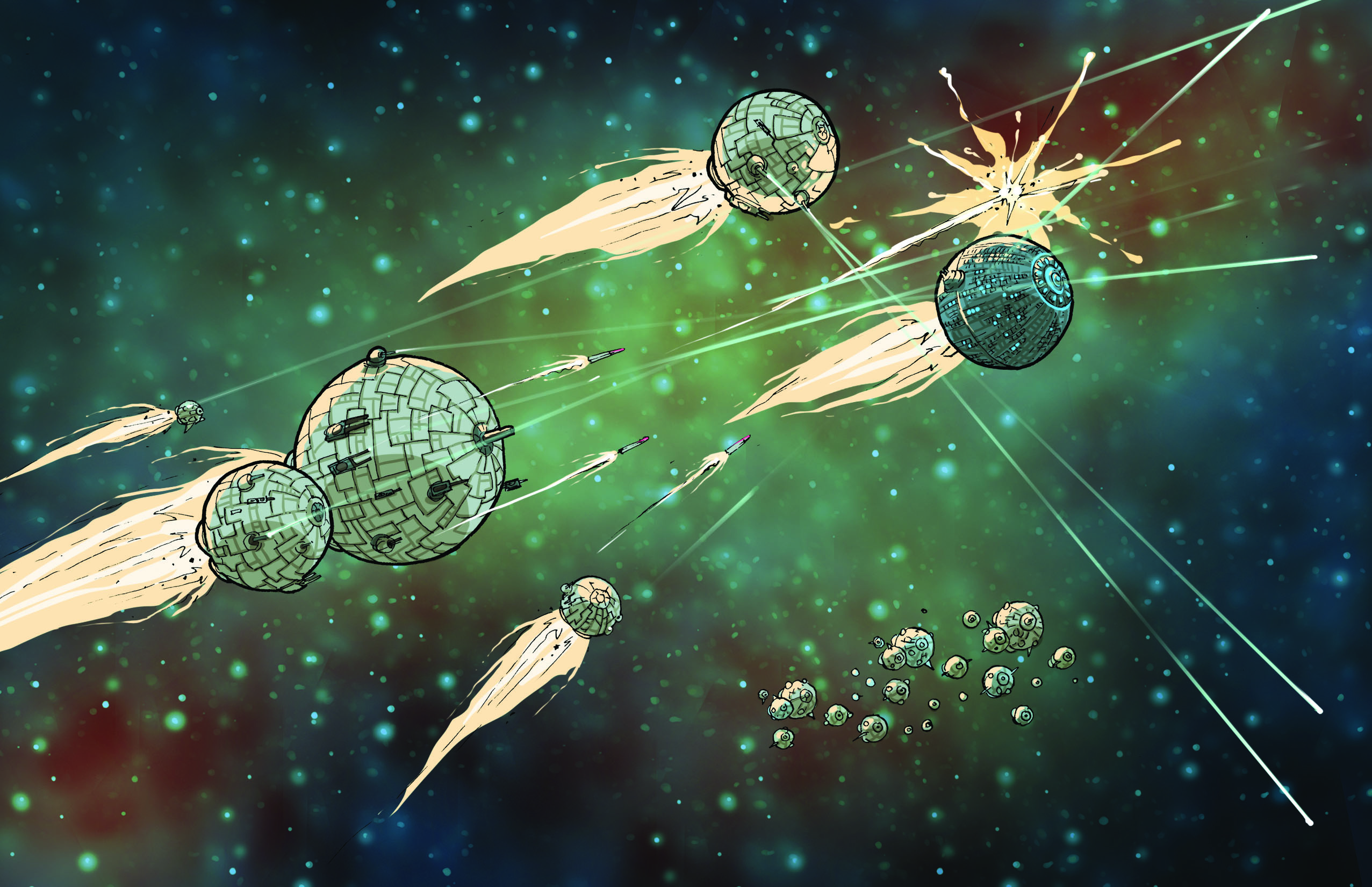Seven Worlds Designer Diary: The Space Battles are Unique!

Savage Worlds already has a great set of vehicle combat and Chase rules. The goal with the Seven Worlds space battle rules was to keep the FFF nature of the original ruleset while at the same time representing the realism of space combat, the way it should really be.
The space combat rules in Seven Worlds cover many unique details about movement, weapons, shields, and much more. But in the end all of that is eclipsed by a single interesting fact that gets ignored in most science-fiction RPGs: In the dead cold of space, what's most likely to kill you is the heat.
Hold on a sec. Did you say Heat!?
Yes, Heat. You can go to the scientifically-inclined Atomic Rockets site to read the details (by the way, did you know that Atomic Rockets has awarded Seven Worlds the Atomic Rockets Seal of Approval for Scientific Accuracy? We couldn't be prouder!). You could also check out the awesome Heat sidebar in the Seven Worlds Setting Guide when it comes out (Don't know about our scientifically-accurate sidebars? Check out the original announcement post for more), but in short:
- Engines, weapons, shields, and even human beings, generate heat.
- Given that space is a vacuum, it is extremely difficult to eliminate heat in space.
- Cooling the ship to maintain livable conditions generates more heat.
- Therefore, without careful and constant heat management, spaceship crews will die a horrible, sweaty death.
Seven Worlds makes space combat unique by taking full advantage of this! Heat accumulates each round of space combat, and it is the players' job to make sure it gets radiated before it harms the ship or crew. In game terms, it works like this:
- Besides having Wounds, all ships have a Heat Fatigue statistic. This works just like normal Fatigue on a character, but applies to a ship.
- All ships also have a Heat Radiation stat. This is a positive bonus that represents how well the ship radiates heat in normal conditions, using especially-designed heat radiators (a scientifically-accurate way to eliminate waste heat) as well as the shield's heat sink.
- Finally, all ships have a Heat Pool. Each action that your characters take during space combat, such as moving the ship, firing lasers and missiles, and receiving and absorbing enemy attacks, generates a cost in heat points that get added to the Heat Pool. By the end of the round, the Heat Pool represents how much heat the ship has accumulated this round.
- Once per round one character (usually the Heat Engineer) makes a special skill roll subtracting the number of points in the Heat Pool, and adding the Heat Radiation stat. If the character succeeds at this roll, she has successfully radiated heat this round. If the character fails the roll, the ship accumulates one point of Heat Fatigue. The Heat Pool then resets to zero, regardless of the result.
Managing Heat makes space battles much more interesting by adding a new layer of group strategy to the game. When a player decides to fire a weapon, or make a maneuver, she must consider the implications of adding that much heat to their own ship for the Ship Engineer to radiate. Also now there's more stuff to do for all the players to do during combat, avoiding a typical vehicle combat complaint ("the pilot and gunner get to have all the fun!"). In fact, Seven Worlds includes several heat-related Edges allowing characters to specialize in Heat Engineering.
What if the ship accumulates too much heat and is in danger of exploding? Combatants have the option to turn off the shields to radiate heat as quickly as possible, at the rate of one point of Fatigue per round. But without shields, the ship loses its Armor bonus, thus becoming especially vulnerable to an enemy hit.
Exciting!

Weapons in Seven Worlds
There are many types of space weapons in Seven Worlds, such as:
- laser beams
- particle beams
- railguns
- four types of missiles
- four types of projectile clouds.
Each weapon has its own special benefits and heat cost, thus bringing more options and excitement to the battle. It goes without saying, but there are notes on the scientific reasoning behind every one of them.
Missiles and projectile clouds are a big thing in this setting, and heavily leverage the Missile rules from Savage Worlds. When designing the game I noticed that these rules are not used much, which is a shame since they are extremely exciting! In fact, missile and projectile battles can become so intense in Seven Worlds that the game includes a handy Projectile Tracking Sheet (available as a download from the Downloads section), something that might also be useful in any other Savage Worlds setting that uses lots of missiles.
Mass Battles
Even with these new rules, space battles between many ships can become burdensome. To help with this, the Setting Guide tweaks the Mass Battle rules to support massive battles between fleets and between capitol ships. Special rules also cover scenarios where small ships go into battle against space stations and other large unmovable targets.
And there you have it: A unique take on space battles that helps you use the Seven Worlds RPG to tell epic stories of adventure in space!
If you're not subscribed to the Seven Worlds mailing list, subscribe now to receive weekly updates like this one, as well as Kickstarter announcements!